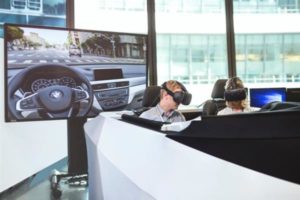BMW combines 3D printing & virtual reality to streamline vehicle design
German auto manufacturer BMW, no stranger to 3D printing technologies, has announced its intention to combine additive manufacturing and virtual reality to help streamline and reduce the costs of its design processes.
 3D printing and virtual reality have been developing side by side for several years, with both technologies becoming more and more advanced and increasingly accessible. It is hardly a surprise then that their trajectories have become intertwined in numerous ways. Earlier today we wrote about one instance of this intersection, as tech company HTC released its new MakeVR tool, which allows HTC Vive users to craft and 3D model in a virtual environment.
3D printing and virtual reality have been developing side by side for several years, with both technologies becoming more and more advanced and increasingly accessible. It is hardly a surprise then that their trajectories have become intertwined in numerous ways. Earlier today we wrote about one instance of this intersection, as tech company HTC released its new MakeVR tool, which allows HTC Vive users to craft and 3D model in a virtual environment.
Now, it seems BMW is seeking to explore the benefits of combining both technologies for its own design-related purposes. In designing and developing a new vehicle, BMW would traditionally have to manufacture one or several prototypes for each part—a time-consuming and costly process. With the advancement of 3D printing, however, this task was made significantly easier, as the company was able to additively manufacture one-off prototypes in a more time and cost efficient manner.
By adding virtual reality into the mix, the car manufacturer is hoping to streamline its design and prototyping process even more. That is, in combining VR tech with 3D printing, BMW is confident that it can simplify and speed up its auto design stage by cutting back on the number of parts that even need to be additively manufactured.
 How is this going to work? Well, BMW is reportedly working on a VR program (in collaboration with Unreal Engine) that is capable of recreating a variety of different surface finishes and features that are integrated into BMW’s vehicles. Using the VR technology, the company plans to project the virtual images onto 3D printed parts to see how they will look when they are finished and built into the car. This will allow BMW’s designers to see any early flaws with a particular design, and allow them to create and adapt a new virtual design.
How is this going to work? Well, BMW is reportedly working on a VR program (in collaboration with Unreal Engine) that is capable of recreating a variety of different surface finishes and features that are integrated into BMW’s vehicles. Using the VR technology, the company plans to project the virtual images onto 3D printed parts to see how they will look when they are finished and built into the car. This will allow BMW’s designers to see any early flaws with a particular design, and allow them to create and adapt a new virtual design.
Additionally, BMW also intends to use virtual reality and 3D printing in tandem in order to increase the efficiency of inter-departmental communications. By using the two technologies together, BMW says it will be easier to convey design ideas and directions to different teams, and will provide a more user-friendly experience for its employees.
For over 25 years, BMW has been a strong proponent of additive manufacturing technologies, not only using it for its own manufacturing needs, but also investing in up-and-coming 3D printing companies, and collaborating with various organizations, including Team USA. As always, we are eager to see its continued use and advancement of the technology.
Source: 3ders.org










